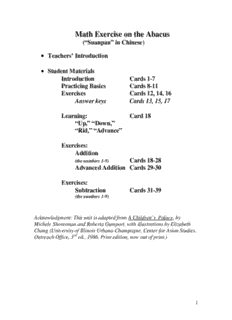
Math Exercise on the Abacus PDF
Preview Math Exercise on the Abacus
Math Exercise on the Abacus (“Suanpan” in Chinese) • Teachers’ Introduction • Student Materials Introduction Cards 1-7 Practicing Basics Cards 8-11 Exercises Cards 12, 14, 16 Answer keys Cards 13, 15, 17 Learning: Card 18 “Up,” “Down,” “Rid,” “Advance” Exercises: Addition Cards 18-28 (the numbers 1-9) Advanced Addition Cards 29-30 Exercises: Subtraction Cards 31-39 (the numbers 1-9) Acknowledgment: This unit is adapted from A Children’s Palace, by Michele Shoresman and Roberta Gumport, with illustrations by Elizabeth Chang (University of Illinois Urbana-Champagne, Center for Asian Studies, Outreach Office, 3rd ed., 1986. Print edition, now out of print.) 1 Teachers’ Introduction: Level: This unit is designed for students who understand p1ace value and know the basic addition and subtraction facts. Goals: 1. The students will learn to manipulate one form of ca1cu1ator used in many Asian countries. 2. The concept of p1ace value will be reinforced. 3. The students will learn another method of adding and subtracting. Instructions • The following student sheets may be copied so that your students have individual sets. • Individual suanpan for your students can be ordered from China Sprout: http://www.chinasprout.com/shop/ Product # A948 or ATG022 Evaluation The students will be able to manipulate a suanpan to set numbers, and to do simple addition and subtraction problems. Vocabulary suanpan set beam rod c1ear ones rod tens rod hundreds rod 2 Card 1 Suanpan – Abacus The abacus is an ancient calculator still used in China and other Asian countries. In Chinese it is called a “Suanpan.” It is a frame divided into an upper and lower section by a bar called the “beam.” The abacus can be used for addition, subtraction, multiplication, and division. 3 Card 2 Clearing the suanpan: • Before you begin work on the Suanpan you must clear it. • This is done by moving all of the beads in the upper section to the top of the frame and all of the beads in the lower section to the bottom of the frame. Clear your Suanpan. It should look like this: 4 Card 3 Using your fingers to move the beads: • Put your Suanpan on your desk. • Hold it with your left hand. • Use your thumb to move the beads in the lower section up. • Use your index finger to move the beads in the lower section down. • Use your middle finger to move the upper section beads up and down. 5 Card 4 The Suanpan has thirteen rods. The exercises we will do will use the first three rods – the ones rod, the tens rod, and the hundreds rod. 6 Card 5 There are two beads on the upper section of each rod and five beads on the lower section of each rod. • Each bead in the upper section has a value of 5. • Each bead in the lower section has a value of 1. *To set a number less than 10, you only need to count and move beads on the ones rod. 7 Card 6 When reading the Suanpan, you count only the beads that have been moved to the beam in the middle. Here are some numbers and how they would look on the Suanpan: 8 Card 7 To set the number 5: (“Set” means to move the beads to the position that shows the number indicated) • move the bead in the upper section of the ones rod down to the beam. (The fifth bottom bead is not used in addition.) • As soon as five bottom beads are needed, clear the bottom section and bring down on bead from the top. 9 Card 8 Practicing Basics Set the numbers 6, 7, 8, and 9. Check your answers with the drawings on Card #9. 10
Description: